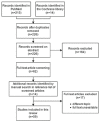Artificial Intelligence Based Algorithms for Prostate Cancer Classification and Detection on Magnetic Resonance Imaging: A Narrative Review
- PMID: 34073627
- PMCID: PMC8229869
- DOI: 10.3390/diagnostics11060959
Artificial Intelligence Based Algorithms for Prostate Cancer Classification and Detection on Magnetic Resonance Imaging: A Narrative Review
Abstract
Due to the upfront role of magnetic resonance imaging (MRI) for prostate cancer (PCa) diagnosis, a multitude of artificial intelligence (AI) applications have been suggested to aid in the diagnosis and detection of PCa. In this review, we provide an overview of the current field, including studies between 2018 and February 2021, describing AI algorithms for (1) lesion classification and (2) lesion detection for PCa. Our evaluation of 59 included studies showed that most research has been conducted for the task of PCa lesion classification (66%) followed by PCa lesion detection (34%). Studies showed large heterogeneity in cohort sizes, ranging between 18 to 499 patients (median = 162) combined with different approaches for performance validation. Furthermore, 85% of the studies reported on the stand-alone diagnostic accuracy, whereas 15% demonstrated the impact of AI on diagnostic thinking efficacy, indicating limited proof for the clinical utility of PCa AI applications. In order to introduce AI within the clinical workflow of PCa assessment, robustness and generalizability of AI applications need to be further validated utilizing external validation and clinical workflow experiments.
Keywords: artificial intelligence; computer-aided diagnosis; deep learning; machine learning; magnetic resonance imaging; prostate neoplasms; radiomics.
Conflict of interest statement
J.J.T., K.G.v.L. and M.d.R. declare no relationships with any companies or services related to the subject matter of this article. J.J.F. and H.J.H. receive research grants from Siemens Healthineers. The funders had no role in the design of the study; in the collection, analyses, or interpretation of data; in the writing of the manuscript, or in the decision to publish the results.
Figures






References
-
- Martín Noguerol T., Paulano-Godino F., Martín-Valdivia M.T., Menias C.O., Luna A. Strengths, Weaknesses, Opportunities, and Threats Analysis of Artificial Intelligence and Machine Learning Applications in Radiology. J. Am. Coll. Radiol. 2019;16:1239–1247. doi: 10.1016/j.jacr.2019.05.047. - DOI - PubMed
-
- Rouvière O., Puech P., Renard-Penna R., Claudon M., Roy C., Mège-Lechevallier F., Decaussin-Petrucci M., Dubreuil-Chambardel M., Magaud L., Remontet L., et al. Use of prostate systematic and targeted biopsy on the basis of multiparametric MRI in biopsy-naive patients (MRI-FIRST): A prospective, multicentre, paired diagnostic study. Lancet Oncol. 2019;20:100–109. doi: 10.1016/S1470-2045(18)30569-2. - DOI - PubMed
Publication types
Grants and funding
LinkOut - more resources
Full Text Sources
Medical

